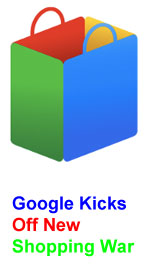 Google is poised to shake up e-commerce to an even greater degree as the company merges its paid Product Listing Ads and its “free” shopping-related results into a single paid format. The process started in the U.S. two months ago and is expected to be completed by the beginning of October, with Asia and Europe planned for 2013.
Google is poised to shake up e-commerce to an even greater degree as the company merges its paid Product Listing Ads and its “free” shopping-related results into a single paid format. The process started in the U.S. two months ago and is expected to be completed by the beginning of October, with Asia and Europe planned for 2013.
In an analyst note, Nomura’s Brian Nowak and Michael Costantini believe the change to a fully paid model for product searches could produce $1.4 billion in incremental revenue for the search giant, once the international rollout goes through. But it’s not just revenues that Google is aiming at — the move reflects a more aggressive approach to e-commerce that involves taking on Amazon more directly.
According to a Forrester study issued this summer, in 2011 about 30 percent of web users went straight to Amazon to search for online shopping; in contrast, 13 percent used Google or other search engines like Bing. At the same time, product searches on Amazon rose 73 percent as Google Shopping remained flat. Amazon’s dominance as the go-to site for product searches seems secure. But there were those who discounted Google’s deeper move into display a few years ago too.
Amazon’s test in June 2011 with demand-side platform Triggit was part of a larger effort to expand its existing retargeting platform. Aside from building up its position as a cynosure for all kinds of digital shopping purchases, the arrangement with Triggit was also seen as a way for Amazon to create a display ad business beyond the considerable ad revenues it gets from banner ads on its site.
As a result, third party sites are being given a choice of larger retargeting players as Amazon and Google battle it out.
In a company blog post, IgnitionOne today said it would feature Google Shopping as part of its Digital Marketing Suite. Claiming to be the first digital marketing platform to integrate Google’s system into its own retargeting process, IgnitionOne’s platform will allow retail marketers to manage Google Product Listing ads side-by-side search, display and Facebook.
That’s not to say that the e-commerce field will only be left to Amazon and Google. After all, eBay has its paid listings product and consumers are even buying cars on the auction site. But where eBay and Amazon have set up established e-tail outlets, Google has always focused its strategies on up-ending the typical way things are done, primarily through its unmatched collection and analysis of user data that goes way beyond shopping (though Google Checkout was never a great success). So as Amazon wisely diversifies its revenue streams with larger advertising programs and devices like the Kindle, Google will be spending the next few months trying to get users — and third party vendors like IgnitionOne — to change their mind about who rules the virtual shopping mall.












